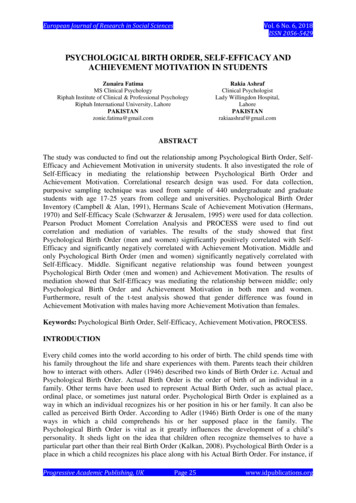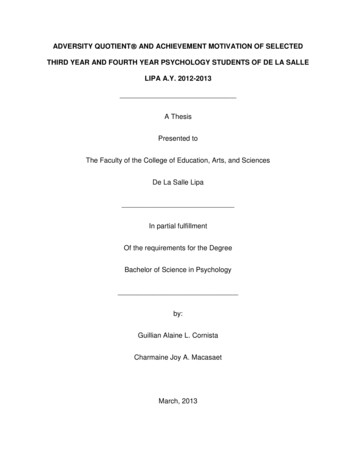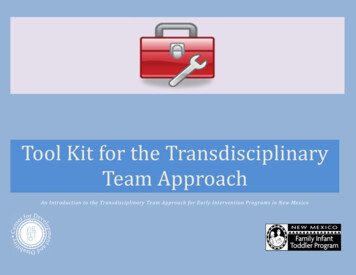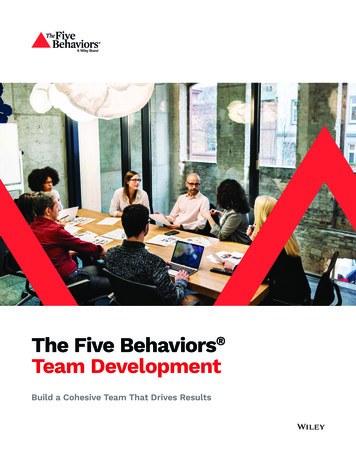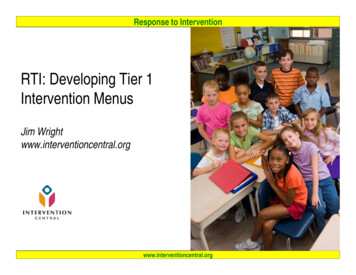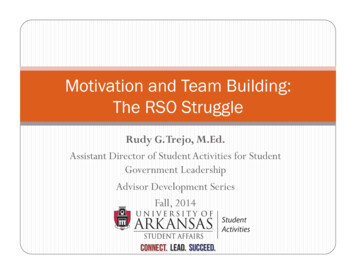
Transcription
Motivation and Team Building:The RSO StruggleRudy G. Trejo, M.Ed.Assistant Director of Student Activities for StudentGovernment LeadershipAdvisor Development SeriesFall, 2014
About Your Facilitator From El Paso, Texas B.A. in Political Science from St. Edward’s University and anM.Ed. in Educational Adminstration from UT-El Paso Currently working on Ed.D. in Educational Admin fromArkansas AD for Student Activities & ASG Advisor 280 Students, 3 Branches, Freshman- Ph.D. Students, 3Functional Areas, 4 Flagship Programs, a dozen events/programs, legislative drafting, communication/messagedevelopment, leadership programming, networking,collaboration, meetings, meetings, meetings!
Give Me Your Experiences Who are You and What Group do You Advise?
So, How Do You Motivate As advisor, motivating and teambuilding is an opportunity totake an active and proactive role with your leadership teamfor the benefit of the entire organization. Often times, because leadership turns over often,YOU needto come in with a game plan and be the first to pose thequestion to your newly elected team: “how are you all goingto keep the group motivated and working together?” This needs to be a high priority with goals and plans needingto be identified early in their term.
It needs to be consistent Your leadership may need a motivation pep-talk here andthere keeping them motivated allows for them to keep therest of the group motivated. What does this look like:Reminding them of their goals and objectivesDoing something funShow your appreciation the small things countBe Intentional about your motivationInspire with your words remind them why they ran, what themission of the organization is, etc. Finally, tie in the transferrable skills they’re going to take awayand learning from.
There is no “I” in team In order to build a strong team, every member of the teamhas to feel like the advisor not only acknowledges theirpresence, but, has a strong rapport/bond. Do you know names of members? Are you approachable? Do you converse with them during and outside of meetings,events, etc.? Do you demonstrate team-efforts as the advisor? The group has to see that the advisor values theirparticipation and also is present at meetings, events, etc. Members have to know that they’re being heldaccountable not just by the president, but by the advisor.
There is no “I” in team
Something Practical You Can Use.
Something Practical To Help The Five Dysfunctions of a Team by Patrick Lencioni
Dysfunction #1: Absence of TrustMembers of great teams trust one another on a fundamental,emotional level, and they are comfortable being vulnerable witheach other about their weaknesses, mistakes, fears, and behaviors.They get to a point where they can be completely open with oneanother, without filers. This is essential because Lencioni, Patrick. The Five Dysfunctions of a Team. San Francisco: Jossey-Bass, 2005. Print.
Dysfunction #2: Fear of ConflictTeams that trust one another are not afraid to engage in passionatedialogue around issues and decisions that are key to theorganization's success. They do not hesitate to disagree with,challenge, and question one another, all in the spirit of findingthe best answers, discovering the truth, and making greatdecisions. This is essential because Lencioni, Patrick. The Five Dysfunctions of a Team. San Francisco: Jossey-Bass, 2005. Print.
Dysfunction #3: Lack of CommitmentTeams that engage in un-filtered conflict are able to achieve genuinebuy in around important decisions, even when various membersof the team initially disagree. That’s because they ensure that allopinions and ideas are put on the table and considered, givingconfidence to team members that no stone has been leftunturned. This is critical because Lencioni, Patrick. The Five Dysfunctions of a Team. San Francisco: Jossey-Bass, 2005. Print.
Dysfunction #4: Avoidance ofAccountabilityTeams that commit to decisions and standards of performance donot hesitate to hold one another accountable for adhering to thosedecisions and standards. What is more they don’t rely on the teamleader as the primary source of accountability, they go directly totheir peers. This is matters because Lencioni, Patrick. The Five Dysfunctions of a Team. San Francisco: Jossey-Bass, 2005. Print.
Dysfunction #5: In attention to ResultsTeams trust one another, engage in conflict, commit to decisions,and hold one another accountable are very likely to set aside theirindividual needs and agendas and focus almost exclusively onwhat is best for the team. They do not give in to the temptation toplace their departments, career aspirations, or ego-driven statusahead of the collective results that define a team’s success.Lencioni, Patrick. The Five Dysfunctions of a Team. San Francisco: Jossey-Bass, 2005. Print.
Questions?
Motivation and Team Building:The RSO StruggleRudy G. Trejo, M.Ed.Assistant Director of Student Activities for StudentGovernment LeadershipAdvisor Development SeriesFall, 2014
of the team initially disagree. That's because they ensure that all opinions and ideas are put on the table and considered, giving confidence to team members that no stone has been left unturned. This is critical because Lencioni, Patrick. The Five Dysfunctions of a Team. San Francisco: Jossey-Bass, 2005. Print.



